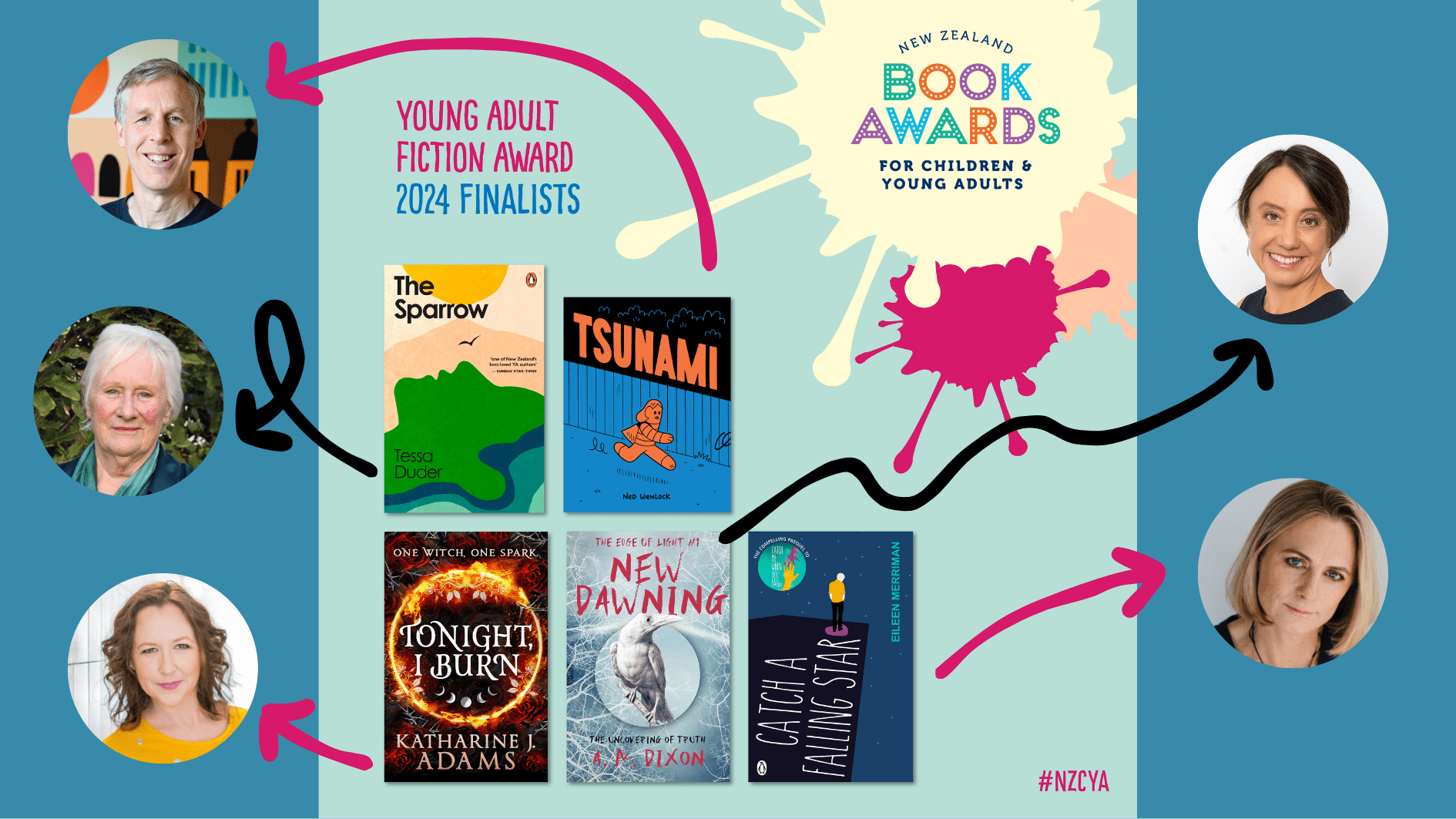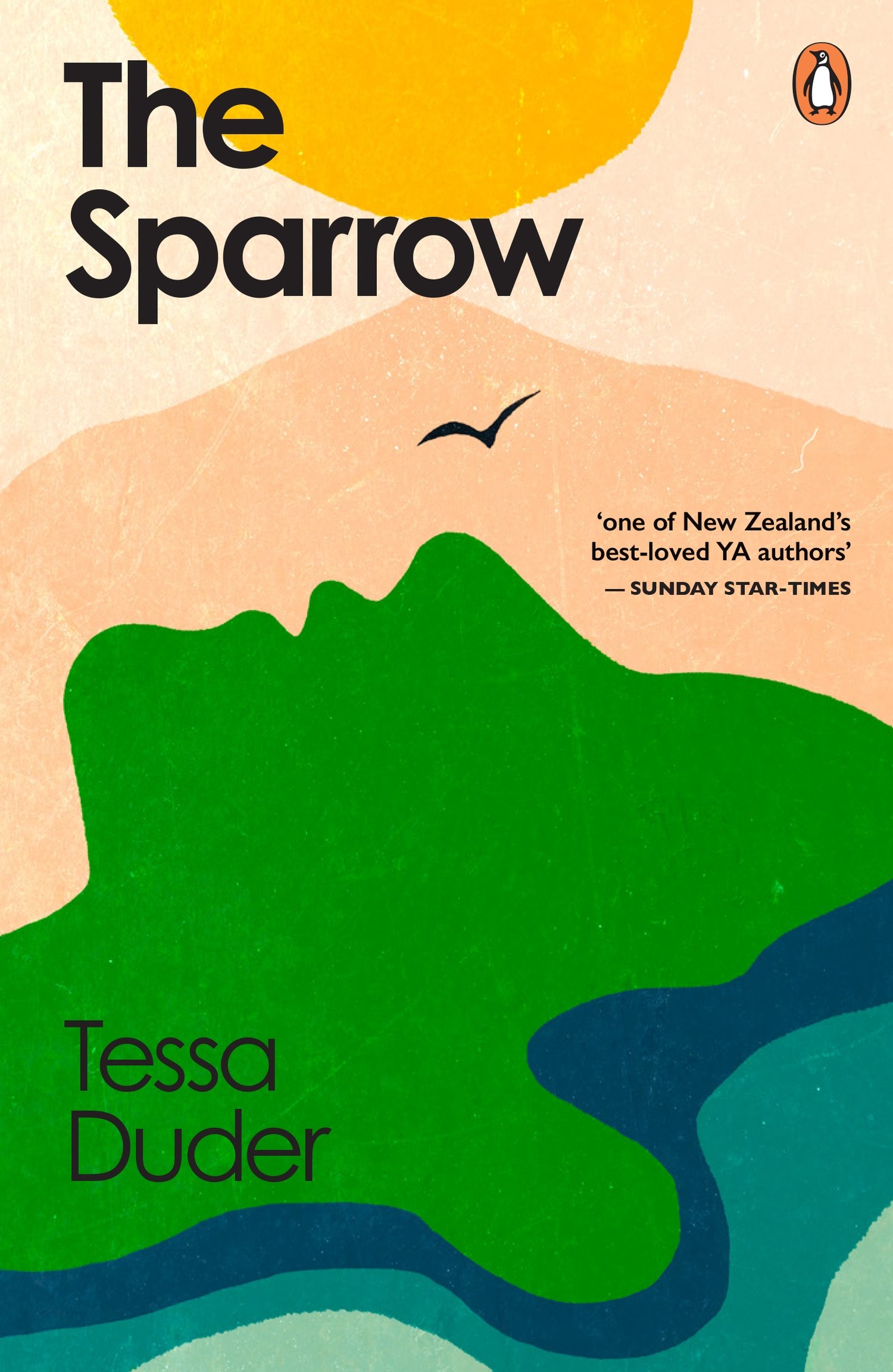This year’s NZCYA YA finalists span a huge range of genres, settings, and themes. From the journey of an escaped convict as she tries to forge a life in colonial Tāmaki Makaurau, to a graphic novel about the struggles of pre-teenhood, to the first instalment of an environmental fantasy trilogy—this year’s finalists bring together a spectrum of stories that are united by their relatability and connection to teenagers. With that in mind, we decided to ask these authors the question: why did you write this book?

Catch a Falling Star, by Eileen Merriman (Penguin Random House)
Outside of my fantasy/sci-fi books, I’ve never written a prequel or sequel before. However, I decided to write Catch A Falling Star, the prequel to Catch Me When You Fall, as I was really interested in telling Jamie Orange’s backstory. Jamie is Alex’s boyfriend in Catch Me When You Fall, which is one of my most popular young adult books, where Alex is battling leukaemia whilst trying to navigate her first serious relationship. I wrote one chapter from Jamie’s point of view in Catch Me When You Fall and was struck by how fun it was to write, and how his distinctively quirky voice immediately leapt off the page.
I decided to write Catch A Falling Star, the prequel to Catch Me When You Fall, as I was really interested in telling Jamie Orange’s backstory
Catch A Falling Star starts a year before Jamie meets Alex, and documents his struggle with the exhilarating highs and terrible lows that lead to his bipolar diagnosis. I’ve always been interested in reducing the stigma with regards to mental health issues, and this felt like the perfect way to do this while also treating fans of Catch Me When You Fall to another dose of Jamie! It has been so much fun to revisit the characters and to introduce some new ones along the way.

The Sparrow, by Tessa Duder (Penguin Random House)
The Sparrow sprang from the research done for my 2015 biography of Sarah Mathew, Auckland’s founding pioneer who gave us the only on-the-spot account of the ceremony on September 18, 1840, declaring Auckland to be the capital of the new colony, New Zealand. Two ships were in the harbour, one carrying the first officials, the other a kitset government house, but both ships also carried a number of mechanics (carpenters, masons, sawyers) and their families. Surely those children must have been terrified by the ships firing off 21- and 15- gun salutes, and equally fascinated by the local waka taking part in what was Auckland’s first regatta?
Among those children is my fictional Harriet, 14, whose story is very different from the rest. As an escaped convict from the notorious Cascades Female Factory in Hobart, she’s only survived her misadventures dressed as a boy. Penniless, homeless and utterly alone, she nevertheless finds work and observes the struggles of the earliest settlers to establish a township, and she also notes the support (food, firewood and raupo huts) provided by local Māori.
I love the sheer vitality of fiction that draws on and illuminates the past
I’m hugely grateful to editor Harriet Allan’s encouragement to greatly expand Harriet’s backstory, as she endures an unjust conviction for stealing an apple, the horrors of Newgate prison in London, transportation by ship to Hobart and the unimaginable prospect of seven years’ imprisonment.
Because the Auckland sections closely follow the historical record, and prominent figures like Governor Hobson and John Logan Campbell appear, extensive reading was required. But neither the research nor writing was arduous, because I love the sheer vitality of fiction that draws on and illuminates the past. I take great pleasure in knowing, especially as our history is again being taught in schools, that with The Sparrow (and the sequel currently being written!), I’m able to share that delight.

A New Dawning, by A. M. Dixon (OneTree House)
My book, A New Dawning, grew out of a story I originally wrote for the Royal Society of New Zealand Manhire Prize for Creative Science Writing. The brief was for a piece of writing set during the time of the next Transit of Venus. I had a lot of fun researching a future Lyttelton, and tied in many ideas of what a post climate-change world might look like here. The story was shortlisted and for many years the characters from that story hung around in my head, so I knew I needed to write a bigger piece based on their world. My background is in environmental science, and I think that writing and reading stories about climate change is one of the most important ways we have of dealing with these huge global issues. Stories make issues real, even if the characters are fictional.
I think that writing and reading stories about climate change is one of the most important ways we have of dealing with these huge global issues
I wanted to write a story which showed characters dealing with climate change and the knock-on effects such as sea-level rise and biodiversity loss, and I wanted to write a story set in and around Lyttelton Harbour/Wakaraupō because this is the landscape I see every day from my place in Governors Bay. I also knew I wanted to write for teenagers – this is a great age group for whom the world often feels full of possibilities. I wanted to capture some of that teenage energy. Because of my science background, it was also important for me to include science themes and try to authentically represent what it’s like to do science in the field. I hope I have succeeded in achieving some of these aims with my characters Merel and Ren, and I hope New Zealand teenagers enjoy reading this book.

Tonight, I Burn, by Katherine J. Adams (Moa Press)
The first three lines of Penny’s story hit me in the middle of the night and wouldn’t let me go: A witch will burn today. This time it isn’t me. This time I’m lighting the match.
It fell out onto the page, fast, raw, and emotional, a witch finding her place in a dark and heavily-controlled world. It explores love and all its different facets, sisters and loyalty, power and its price. It is also, at its heart, a story about stories, which wind their tendrils around Penny and the whole messy Resistance gang. I intentionally wrote a Queer-normative world. Penny has a lot of obstacles, but her sexuality is never one of them.
When I was younger, YA books weren’t really a thing. The teen section in my local library was housed in a small, uninspiring corner, and the bookstore didn’t give it shelf space. Books with positive LGBTQ+ rep weren’t written for teens and children. I wish they had been. Relationships aren’t one size fits all, and I wanted to write a story which celebrated that whilst not being the focus of it. LGBTQ+ teens (and adults) are more than their identity on the rainbow, and they deserve to see themselves on the page without their orientation or coming out being the focus of every story.
LGBTQ+ teens (and adults) are more than their identity on the rainbow, and they deserve to see themselves on the page without their orientation or coming out being the focus of every story
I did find one LGBTQ+ book as a teen, a single gentle kiss hidden in its pages, and it let me be me inside my head when I didn’t have the words for who I was and what I was trying to hide. I can’t remember the name of that book…maybe one day I’ll find it again. Now, Penny and Alice and Malin fill the shape of that space in my heart.
It makes me so happy that they’re finding a space in others’ hearts too.

Tsunami, by Ned Wenlock (Earths End Publishing)
The true answer is, I don’t know why I wrote this book.
I didn’t know what I was getting into when I started, and I wasn’t prepared for how personal the story became as it unfolded. It’s only now, looking back, that it makes sense to me.
In the beginning I had very little to go on, just a few basic ingredients. A stubborn, righteous, twelve-year-old boy for my main character. A re-imagined Kāpiti Coast for the setting. And a simple concept: how does a good kid get into the worst trouble imaginable?
These elements excited me. The main character, Peter, is roughly based on myself at that age. A kid who is a little bit at odds with the world, righteous in nature as a way to order and control his own life. Throw him into a very ordinary environment with down-to-earth characters you might find on the Kāpiti Coast (where I’ve lived for the last ten years), he becomes a fish out of water, particularly when a small inciting incident accidentally puts Peter in the wrong. Another kid might concede, but not Peter—he’s never wrong, particularly when he feels that justice is not being served.
Looking back, I see that the story unconsciously mirrors my own time at the same age
Looking back, I see that the story unconsciously mirrors my own time at the same age. My family moved to New Zealand on my thirteenth birthday, leaving my friends in the UK behind. We moved again when I was fourteen, to the country, which meant I had to go boarding to attend high school. This whole period was very stressful but particularly the boarding, which is where I’ve taken some of the incidents that happen in the book. I realise now the tone of dread in the book captures my early teenage years perfectly. Dread is the fear that something terrible will happen, and as unpleasant as some readers have found the ending to Tsunami, it’s true in spirit, if not in reality, to my early teenage self.




